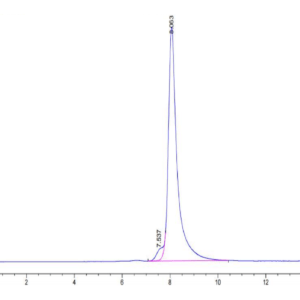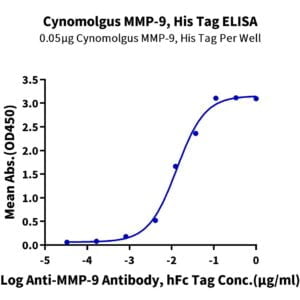| Weight | 1 lbs |
|---|---|
| Dimensions | 9 × 5 × 2 in |
| accession | Q9NQ25 |
| express system | HEK293 |
| product tag | C-mFc |
| purity | > 95% as determined by Tris-Bis PAGE;> 95% as determined by HPLC |
| background | CD2-like receptor activating cytotoxic cells (CRACC), also known as CS1, novel Ly9, SLAMF7, and CD319, is a 65-75 kDa type I transmembrane glycoprotein in the SLAM subgroup of the CD2 family.Self-ligand receptor of the signaling lymphocytic activation molecule (SLAM) family. SLAM receptors triggered by homo- or heterotypic cell-cell interactions are modulating the activation and differentiation of a wide variety of immune cells and thus are involved in the regulation and interconnection of both innate and adaptive immune response. |
| molecular weight | The protein has a predicted MW of 48.8 kDa. Due to glycosylation, the protein migrates to 68-72 kDa based on Tris-Bis PAGE result. |
| available size | 100 µg, 500 µg |
| endotoxin | Less than 1EU per μg by the LAL method. |
Human SLAMF7/CRACC/CD319 Protein 4619
$315.00 – $1,050.00
Summary
- Expression: HEK293
- Functional: Yes (ELISA)
- Amino Acid Range: Ser23-Met226
Human SLAMF7/CRACC/CD319 Protein 4619
| protein |
|---|
| Size and concentration 100, 500µg and lyophilized |
| Form Lyophilized |
| Storage Instructions Valid for 12 months from date of receipt when stored at -80°C. Recommend to aliquot the protein into smaller quantities for optimal storage. Please minimize freeze-thaw cycles. |
| Storage buffer Shipped at ambient temperature. |
| Purity > 95% as determined by Tris-Bis PAGE |
| target relevance |
|---|
| CD2-like receptor activating cytotoxic cells (CRACC), also known as CS1, novel Ly9, SLAMF7, and CD319, is a 65-75 kDa type I transmembrane glycoprotein in the SLAM subgroup of the CD2 family.Self-ligand receptor of the signaling lymphocytic activation molecule (SLAM) family. SLAM receptors triggered by homo- or heterotypic cell-cell interactions are modulating the activation and differentiation of a wide variety of immune cells and thus are involved in the regulation and interconnection of both innate and adaptive immune response. |
| Protein names SLAM family member 7 (CD2 subset 1) (CD2-like receptor-activating cytotoxic cells) (CRACC) (Membrane protein FOAP-12) (Novel Ly9) (Protein 19A) (CD antigen CD319) |
| Gene names SLAMF7,SLAMF7 CS1 UNQ576/PRO1138 |
| Mass 9606Da |
| Function Self-ligand receptor of the signaling lymphocytic activation molecule (SLAM) family. SLAM receptors triggered by homo- or heterotypic cell-cell interactions are modulating the activation and differentiation of a wide variety of immune cells and thus are involved in the regulation and interconnection of both innate and adaptive immune response. Activities are controlled by presence or absence of small cytoplasmic adapter proteins, SH2D1A/SAP and/or SH2D1B/EAT-2. Isoform 1 mediates NK cell activation through a SH2D1A-independent extracellular signal-regulated ERK-mediated pathway (PubMed:11698418). Positively regulates NK cell functions by a mechanism dependent on phosphorylated SH2D1B. Downstream signaling implicates PLCG1, PLCG2 and PI3K (PubMed:16339536). In addition to heterotypic NK cells-target cells interactions also homotypic interactions between NK cells may contribute to activation. However, in the absence of SH2D1B, inhibits NK cell function. Acts also inhibitory in T-cells (By similarity). May play a role in lymphocyte adhesion (PubMed:11802771). In LPS-activated monocytes negatively regulates production of pro-inflammatory cytokines (PubMed:23695528).; Isoform 3 does not mediate any NK cell activation. |
| Catalytic activity #N/A |
| Subellular location Membrane; Single-pass type I membrane protein. |
| Tissues Expressed in spleen, lymph node, peripheral blood leukocytes, bone marrow, small intestine, stomach, appendix, lung and trachea. Expression was detected in NK cells, activated B-cells, NK-cell line but not in promyelocytic, B-, or T-cell lines. Expressed in monocytes. Isoform 3 is expressed at much lower level than isoform 1. |
| Structure Isoform 1 binds to SH2D1A when its cytoplasmic tail is phosphorylated in the presence of FYN (in vitro); low affinity binding, the physiological relevance of the interaction is questioned. Interacts with SH2D1B; in NK cells (PubMed:16339536). Interacts (via ITSM phosphorylated on Tyr-302) with SH2D1B, PTPN6/SHP-1, PTPN11/SHP-2, INPP5D/SHIP1, CSK and FYN (By similarity). |
| Domain Th |
| Target Relevance information above includes information from UniProt accession: Q9NQ25 |
| The UniProt Consortium |
Data
Publications
Publications
| pmid | title | authors | citation |
|---|---|---|---|
| We haven't added any publications to our database yet. | |||
Protocols
| relevant to this product |
|---|
Documents
| # | ||
|---|---|---|
| Please enter your product and batch number here to retrieve product datasheet, SDS, and QC information. | ||

















